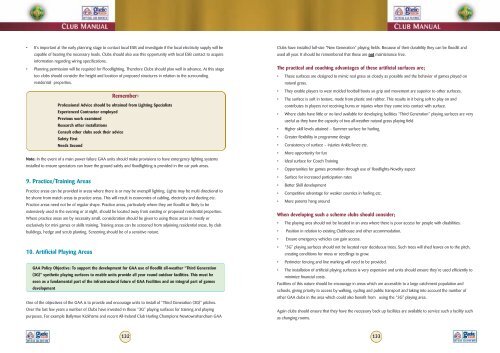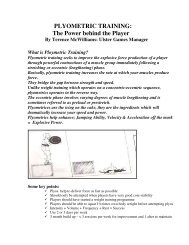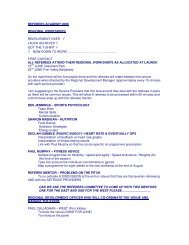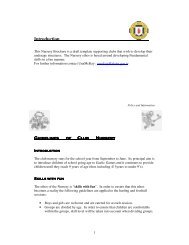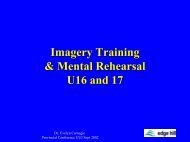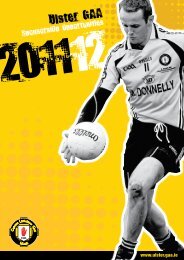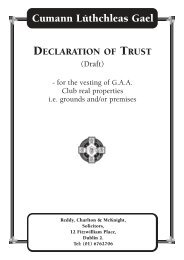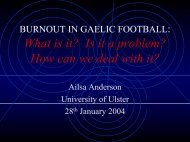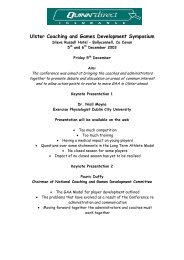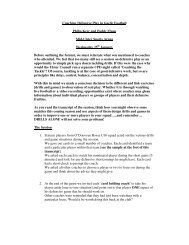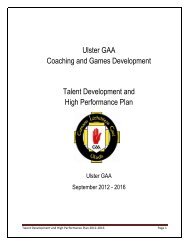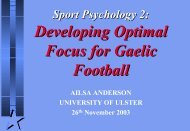Club Manual - Ulster GAA
Club Manual - Ulster GAA
Club Manual - Ulster GAA
Create successful ePaper yourself
Turn your PDF publications into a flip-book with our unique Google optimized e-Paper software.
• It’s important at the early planning stage to contact local ESB and investigate if the local electricity supply will be<br />
capable of bearing the necessary loads. <strong>Club</strong>s should also use this opportunity with local ESB contact to acquire<br />
information regarding wiring specifications.<br />
• Planning permission will be required for Floodlighting. Therefore <strong>Club</strong>s should plan well in advance. At this stage<br />
too clubs should consider the height and location of proposed structures in relation to the surrounding<br />
residential properties.<br />
Remember:<br />
Professional Advice should be obtained from Lighting Specialists<br />
Experienced Contractor employed<br />
Previous work examined<br />
Research other installations<br />
Consult other clubs seek their advice<br />
Safety First<br />
Needs Second<br />
Note: In the event of a main power failure <strong>GAA</strong> units should make provisions to have emergency lighting systems<br />
installed to ensure spectators can leave the ground safely and floodlighting is provided in the car park areas.<br />
9. Practice/Training Areas<br />
Practice areas can be provided in areas where there is or may be overspill lighting. Lights may be multi directional to<br />
be shone from match areas to practice areas. This will result in economies of cabling, electricity and ducting etc.<br />
Practice areas need not be of regular shape. Practice areas, particularly where they are floodlit or likely to be<br />
extensively used in the evening or at night, should be located away from existing or proposed residential properties.<br />
Where practice areas are by necessity small, consideration should be given to using these areas in mostly or<br />
exclusively for mini games or skills training. Training areas can be screened from adjoining residential areas, by club<br />
buildings, hedge and scrub planting. Screening should be of a sensitive nature.<br />
10. Artificial Playing Areas<br />
<strong>GAA</strong> Policy Objective: To support the development for <strong>GAA</strong> use of floodlit all-weather “Third Generation<br />
(3G)” synthetic playing surfaces to enable units provide all year round outdoor facilities. This must be<br />
seen as a fundamental part of the infrastructural future of <strong>GAA</strong> Facilities and an integral part of games<br />
development<br />
One of the objectives of the <strong>GAA</strong> is to provide and encourage units to install of “Third Generation (3G)” pitches.<br />
Over the last few years a number of <strong>Club</strong>s have invested in these “3G” playing surfaces for training and playing<br />
purposes. For example Ballymun Kickhams and recent All-Ireland <strong>Club</strong> Hurling Champions Newtownshandrum <strong>GAA</strong><br />
<strong>Club</strong>s have installed full-size “New Generation” playing fields. Because of their durability they can be floodlit and<br />
used all year. It should be remembered that these are not maintenance free.<br />
The practical and coaching advantages of these artificial surfaces are;<br />
• These surfaces are designed to mimic real grass as closely as possible and the behavior of games played on<br />
natural grass.<br />
• They enable players to wear molded football boots so grip and movement are superior to other surfaces.<br />
• The surface is soft in texture, made from plastic and rubber. This results in it being soft to play on and<br />
contributes in players not receiving burns or injuries when they come into contact with surface.<br />
• Where clubs have little or no land available for developing facilities “Third Generation” playing surfaces are very<br />
useful as they have the capacity of two all-weather natural grass playing field<br />
• Higher skill levels attained – Summer surface for hurling<br />
• Greater flexibility in programme design<br />
• Consistency of surface – injuries Ankle/knee etc.<br />
• More opportunity for fun<br />
• Ideal surface for Coach Training<br />
• Opportunities for games promotion through use of floodlights-Novelty aspect<br />
• Surface for increased participation rates<br />
• Better Skill development<br />
• Competitive advantage for weaker counties in hurling etc.<br />
• More parents hang around<br />
When developing such a scheme clubs should consider;<br />
• The playing area should not be located in an area where there is poor access for people with disabilities.<br />
• Position in relation to existing <strong>Club</strong>house and other accommodation.<br />
• Ensure emergency vehicles can gain access.<br />
• “3G” playing surfaces should not be located near deciduous trees. Such trees will shed leaves on to the pitch,<br />
creating conditions for moss or seedlings to grow.<br />
• Perimeter fencing and line marking will need to be provided.<br />
• The installation of artificial playing surfaces is very expensive and units should ensure they’re used efficiently to<br />
minimize financial costs.<br />
Facilities of this nature should be encourage in areas which are accessible to a large catchment population and<br />
schools, giving priority to access by walking, cycling and public transport and taking into account the number of<br />
other <strong>GAA</strong> clubs in the area which could also benefit from using the “3G” playing area.<br />
Again clubs should ensure that they have the necessary back up facilities are available to service such a facility such<br />
as changing rooms.<br />
132<br />
133


